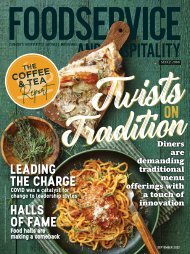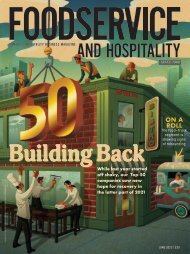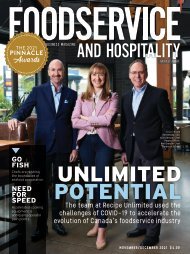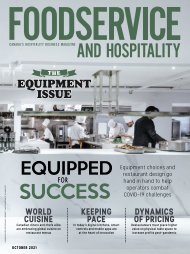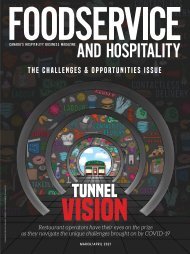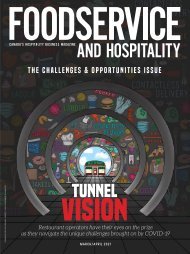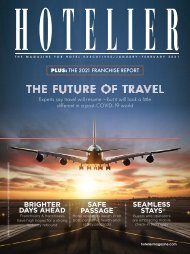November/December 2020
November/December 2020 issue of Foodservice and Hospitality magazine.
November/December 2020 issue of Foodservice and Hospitality magazine.
Create successful ePaper yourself
Turn your PDF publications into a flip-book with our unique Google optimized e-Paper software.
During the height of shutdowns,<br />
many, including Liberty<br />
Entertainment Group, took<br />
the time to assess their options<br />
before implementing an offpremise<br />
strategy. Its first focus<br />
was its casual Italian-food brand<br />
Cibo Wine Bar, which already<br />
had some delivery presence.<br />
“[We] increased the offers we<br />
had, did things to make it better<br />
[and] we even went into things<br />
that were never offered before,”<br />
says Di Donato, explaining that<br />
Cibo began selling cook-athome<br />
meals.<br />
While JRG also implemented<br />
new offerings — including meal<br />
and cocktail kits — as it shifted to<br />
off-site dining, Moreno says the<br />
company found itself in a somewhat<br />
more favourable position<br />
than some of its competitors, as<br />
its portfolio of public houses and<br />
upscale-casual restaurants already<br />
had established digital-ordering<br />
channels. The company had<br />
also launched its ghost-kitchen<br />
platform, Meal Ticket Brands, in<br />
2019, which Moreno credits with<br />
helping get the company through<br />
the shutdowns.<br />
“We were extremely lucky we<br />
had launched this delivery concept<br />
prior [to the pandemic],” he<br />
says. “We didn’t have to lay off<br />
any of our management across<br />
the company…they were the<br />
ones, from the front and back<br />
of the restaurant, operating the<br />
delivery out of our stores.”<br />
Moreno also credits its focus<br />
on more suburban locations in<br />
the Fraser Valley with helping JRG<br />
maintain demand at its restaurants,<br />
explaining these locations are<br />
more community focused and<br />
less reliant on tourism or office/<br />
business clientele.<br />
Di Donato points out that,<br />
generally, fine-dining restaurants<br />
were not well equipped to quickly<br />
pivot their operations during<br />
shutdown. But, after enhancing<br />
Cibo’s delivery offerings, the<br />
company began testing delivery<br />
for its Blue Blood Steak House.<br />
“We weren’t sure it would resonate,<br />
FOODSERVICEANDHOSPITALITY.COM<br />
Commercial Foodservice Sales, march and april <strong>2020</strong><br />
(vs. March and April 2019)<br />
-37.1%<br />
Total<br />
March<br />
-61.4%<br />
April<br />
because [it’s] high end, very<br />
expensive,” he says. But the company<br />
was ultimately surprised by<br />
its success. “People were getting<br />
tired of the same old food and<br />
were ready to have a special meal<br />
at home, so we filled that gap with<br />
Blue Blood.”<br />
“[COVID-19 has] forced a<br />
lot of restaurants that were<br />
never interested in online<br />
ordering [to] all of a sudden<br />
start scrambling and looking<br />
for a solution,” says Hopkins.<br />
“Now, if you don’t have that,<br />
you’re behind.”<br />
With the re-opening of<br />
on-premise dining, FSRs<br />
saw a significant increase in<br />
sales (dollars), which grew<br />
58.3 per cent in June from<br />
the previous month, according<br />
to Statistics Canada.<br />
However, the segment’s<br />
unadjusted sales for June<br />
<strong>2020</strong> were still down 51.8<br />
per cent in year-over-year<br />
comparison.<br />
And, with the return of cooler<br />
weather, full service is expected<br />
to see renewed challenges. “In the<br />
table-service [segment], whether<br />
it’s upscale-casual, casual-family<br />
or high-end dining, we’re going<br />
to see price increases over the<br />
next little while,” says Hopkins,<br />
citing the end of patio season and<br />
decreasing government support.<br />
“The only way that restaurants<br />
with reduced capacity can remain<br />
Full-Service<br />
Restaurants<br />
-49.3%<br />
-78.1%<br />
profitable is to increase prices.”<br />
ALTERNATIVE CHANNELS<br />
Given the current uncertainty<br />
and ongoing shifts in consumer<br />
behaviour, Charlebois says, “This<br />
blurring line we’ve been talking<br />
about for many years, between<br />
service and retail, is going to<br />
become even more interesting…<br />
COVID-19 just blew everything<br />
up — there’s no line anymore, it’s<br />
just food.”<br />
As an example, he points<br />
to Loblaws’ recent collaboration<br />
with Toronto<br />
restaurants for meal-kit<br />
offerings, adding<br />
he expects to see<br />
more initiatives<br />
Quick-Service<br />
Restaurants Caterers Drinking places<br />
-23.6%<br />
-40.6%<br />
-33.3%<br />
-74.7%<br />
-58.1%<br />
-90.5%<br />
Source: Canada/Foodservice Facts <strong>2020</strong><br />
like this in the future. The launch<br />
saw Loblaws add dishes from<br />
Burger’s Priest, La Carnita, Fresh<br />
Restaurants, Fat Lamb Kouzina,<br />
General Assembly Pizza, Kinton<br />
Ramen and Sala Modern Thai to<br />
its PC Chef Meal Kits direct-tohome<br />
delivery service.<br />
“Probably the most important<br />
While loosened<br />
restrictions and<br />
warmer weather<br />
created more<br />
opportunities for<br />
restaurants, many<br />
full-service<br />
restaurants continued to face<br />
challenges. Statistics Canada<br />
reported 32 per cent of FSRs<br />
were closed for part of June<br />
(compared with 44 per cent in<br />
May and 65 per cent in April)<br />
and 11 per cent were closed<br />
for the entire month of June.<br />
NOVEMBER/DECEMBER <strong>2020</strong> FOODSERVICE AND HOSPITALITY 25





